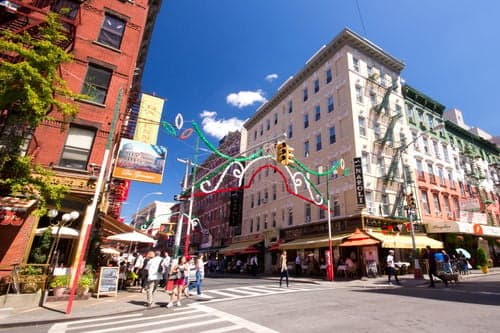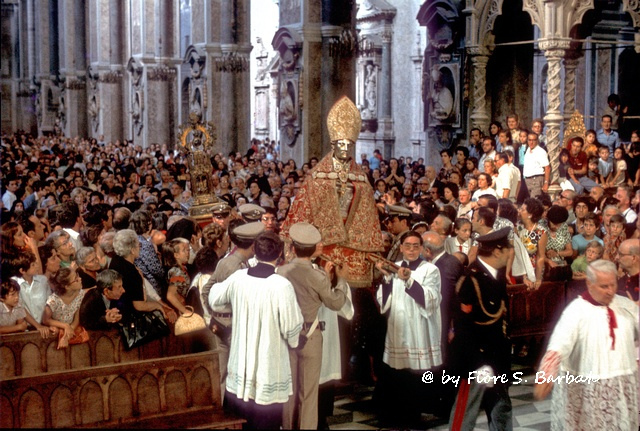The Feast of San Gennaro in New York: the biggest Italian street fair outside of Italy?

This weekend New Yorkers celebrate the Feast of San Gennaro, an 11-day-long street fair now in its 92nd year. What is the Feast of San Gennaro, and how did it become so popular outside of Italy?
The Local has you covered with this handy primer.
It’s that time of year again! #SanGennaro Festival in #LittleItaly, #NYC. @SanGennaroNYC pic.twitter.com/Lat0VEKgEp
— Anthony J. Gullo, CPA, CCIM (@ajgullo) September 16, 2018
Who was San Gennaro?
San Gennaro (sometimes called Saint Januarius in English) is the patron saint of Naples, martyred in AD 305 by the Emperor Diocletian for his Christian faith.
Legend holds that Gennaro, the Bishop of Benevento, was on his way to Pozzuoli to visit his friend Sissios in jail when he was intercepted by the emperor's forces and eventually beheaded, after an initial unsuccessful attempt to have him eaten by wild animals.

San Gennaro by Caravaggio
According to Catholic tradition, a pious woman named Eusebia collected the bishop's blood in two glass ampoules as it drained from his body.
First in 1389, and then on several occasions over the following centuries, it was reported that the blood had spontaneously liquefied inside the ampoules. The Church later declared the phenomenon a miracle.
Today the faithful gather three times a year in Naples - September 19, December 16, and the first Sunday in May - to witness the blood liquefy. A fast liquefaction process is considered a positive omen, while a lengthy process is inauspicious.

The Festa di San Gennaro in Naples. Photo: Fiore Silvestro Barbato/Flickr
When does the festival take place?
Neapolitans celebrate the Festa di San Gennaro on September 19, the day of Gennaro's martyrdom.
In New York City's Little Italy, however, Italian Americans celebrate the Feast of San Gennaro with an 11-day run of festivities which this year begins on September 13 and ends September 23.
What's the history behind the fair?
The first Feast of San Gennaro in New York was held in 1926 on Mulberry Street by newly arrived immigrants from Naples who wanted to continue their annual tradition of venerating their patron saint in their new home.
The statue of San Gennaro ahead of tonight’s procession! #SanGennaro #NYC pic.twitter.com/WRBwdATHFr
— The Feast Of San Gennaro NYC (@SanGennaroNYC) September 19, 2018
It was hugely popular among locals and has run annually ever since, expanding into a days-long street fair that holds claim to the title of New York's longest-running food festival.
The festival includes a celebratory mass at the Church of the Most Precious Blood, following which the statue of San Gennaro is carried in a procession through the streets of Little Italy.
Coca la San Gennaro! ??????❤️ pic.twitter.com/KtscKG6Ktm
— The Feast Of San Gennaro NYC (@SanGennaroNYC) September 21, 2018
What does the fair consist of?
As with all Italian festivals, food plays a major role in Feast of San Gennaro, with traditional Italian foods such as prosciutto, cannoli, sausages, and pizza all on abundant offer.
Stopping off at DiPalo’s for a light snack. pic.twitter.com/B0AaXLDnEY
— The Feast Of San Gennaro NYC (@SanGennaroNYC) September 15, 2018
If you're feeling brave you can sign up for the famous cannoli-eating competition.
This year's winner, Wayne Algenio, crammed in 33 cannoli in 10 minutes.
Highlights from today’s Cannoli Eating Competition! #SanGennaro pic.twitter.com/3Uvzjtwzgm
— The Feast Of San Gennaro NYC (@SanGennaroNYC) September 14, 2018
But food isn't the event's only attraction. There's also plenty of music and dancing.
The incredible @cityrhythmphila has got the crowd moving! #SanGennaro pic.twitter.com/MPIww6wIFD
— The Feast Of San Gennaro NYC (@SanGennaroNYC) September 17, 2018
Carnival games are also on offer...
And if you're feeling overwhelmed by the crowds you can always escape in a ferris wheel.
Have you been to the Feast of San Gennaro in Little Italy? Did we miss anything? Let us know!
Comments
See Also
It’s that time of year again! #SanGennaro Festival in #LittleItaly, #NYC. @SanGennaroNYC pic.twitter.com/Lat0VEKgEp
— Anthony J. Gullo, CPA, CCIM (@ajgullo) September 16, 2018
Who was San Gennaro?
San Gennaro (sometimes called Saint Januarius in English) is the patron saint of Naples, martyred in AD 305 by the Emperor Diocletian for his Christian faith.
Legend holds that Gennaro, the Bishop of Benevento, was on his way to Pozzuoli to visit his friend Sissios in jail when he was intercepted by the emperor's forces and eventually beheaded, after an initial unsuccessful attempt to have him eaten by wild animals.

San Gennaro by Caravaggio
According to Catholic tradition, a pious woman named Eusebia collected the bishop's blood in two glass ampoules as it drained from his body.
First in 1389, and then on several occasions over the following centuries, it was reported that the blood had spontaneously liquefied inside the ampoules. The Church later declared the phenomenon a miracle.
Today the faithful gather three times a year in Naples - September 19, December 16, and the first Sunday in May - to witness the blood liquefy. A fast liquefaction process is considered a positive omen, while a lengthy process is inauspicious.

The Festa di San Gennaro in Naples. Photo: Fiore Silvestro Barbato/Flickr
When does the festival take place?
Neapolitans celebrate the Festa di San Gennaro on September 19, the day of Gennaro's martyrdom.
In New York City's Little Italy, however, Italian Americans celebrate the Feast of San Gennaro with an 11-day run of festivities which this year begins on September 13 and ends September 23.
What's the history behind the fair?
The first Feast of San Gennaro in New York was held in 1926 on Mulberry Street by newly arrived immigrants from Naples who wanted to continue their annual tradition of venerating their patron saint in their new home.
The statue of San Gennaro ahead of tonight’s procession! #SanGennaro #NYC pic.twitter.com/WRBwdATHFr
— The Feast Of San Gennaro NYC (@SanGennaroNYC) September 19, 2018
It was hugely popular among locals and has run annually ever since, expanding into a days-long street fair that holds claim to the title of New York's longest-running food festival.
The festival includes a celebratory mass at the Church of the Most Precious Blood, following which the statue of San Gennaro is carried in a procession through the streets of Little Italy.
Coca la San Gennaro! ??????❤️ pic.twitter.com/KtscKG6Ktm
— The Feast Of San Gennaro NYC (@SanGennaroNYC) September 21, 2018
What does the fair consist of?
As with all Italian festivals, food plays a major role in Feast of San Gennaro, with traditional Italian foods such as prosciutto, cannoli, sausages, and pizza all on abundant offer.
Stopping off at DiPalo’s for a light snack. pic.twitter.com/B0AaXLDnEY
— The Feast Of San Gennaro NYC (@SanGennaroNYC) September 15, 2018
If you're feeling brave you can sign up for the famous cannoli-eating competition.
This year's winner, Wayne Algenio, crammed in 33 cannoli in 10 minutes.
Highlights from today’s Cannoli Eating Competition! #SanGennaro pic.twitter.com/3Uvzjtwzgm
— The Feast Of San Gennaro NYC (@SanGennaroNYC) September 14, 2018
But food isn't the event's only attraction. There's also plenty of music and dancing.
The incredible @cityrhythmphila has got the crowd moving! #SanGennaro pic.twitter.com/MPIww6wIFD
— The Feast Of San Gennaro NYC (@SanGennaroNYC) September 17, 2018
Carnival games are also on offer...
And if you're feeling overwhelmed by the crowds you can always escape in a ferris wheel.
Have you been to the Feast of San Gennaro in Little Italy? Did we miss anything? Let us know!
Join the conversation in our comments section below. Share your own views and experience and if you have a question or suggestion for our journalists then email us at [email protected].
Please keep comments civil, constructive and on topic – and make sure to read our terms of use before getting involved.
Please log in here to leave a comment.